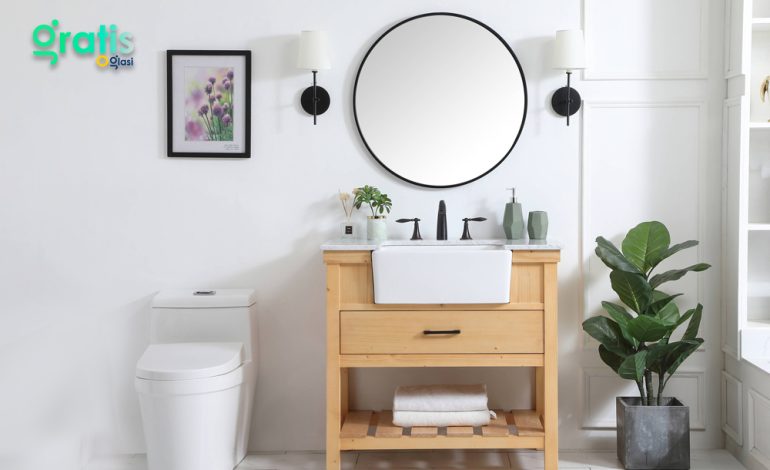
White Vanity Dos and Don’ts of Cleaning and Maintaining
A clean white vanity looks classy and modern in any bathroom or dressing area. To keep its shine and beauty, you must be extra careful when cleaning it. If you want your white vanity to last as long as possible, you should know how to clean and take care of it properly, whether you just bought it or have had it for a while. In addition to being functional, white desks can be used as decorative pieces in bathrooms and dressing rooms, giving them a classy look. The same is valid for keeping them looking great and lasting longer: they must be cleaned and appropriately supported.
Dos of Cleaning and Maintaining Your White Vanity
- Use Mild Cleaners
Use soft, non-abrasive cleaning products on your white desk to keep the finish from getting damaged. You only need a mild cleaner or a mixture of a mild cleanser and warm water for everyday cleaning. You could also use cleaners that are made to be safe for use on white surfaces.
- Cleaning Spills Immediately

Immediately clean up spills to prevent staining or damage to the finish of your white vanity. Use a soggy material or paper towel to smear up spills when they happen, then tenderly wipe the region with a gentle cleaner. Avoid scouring or cleaning enthusiastically, as this can spread the stain or harm the surface.
- Gentle Scrubbing
While managing stubborn stains or soil development, choose delicate scouring utilizing a delicately seethed brush or wipe. Avoid grating devices that can start to expose what’s underneath or leave unattractive imprints. For difficult stains, permit the cleaner to sit briefly before tenderly scouring in a round movement.
- Regular Dusting
Residue can gather rapidly on surfaces, making your white vanity seem dull and unappealing. Ordinary cleaning with delicate microfiber fabric eliminates dust and keeps it from sinking into holes and corners.
- Protect from Moisture
Excessive dampness can twist or stain the wood and materials utilized in white vanities. Use napkins or plates to get dribbles and spills around sinks to safeguard your vanity from dampness. Moreover, it guarantees legitimate ventilation in the restroom to lessen moistness levels and forestall form and buildup development.
- Avoid Abrasive Tools
Avoid grating cleaning devices like steel fleece, scouring cushions, or harsh wipes, as they can scratch or harm the outer layer of your white vanity. All things being equal, pick delicate fabrics, microfiber towels, or delicate brushes to perfect and clean surfaces without genuinely hurting.
Don’ts of Cleaning and Maintaining Your White Vanity

- Excessive Moisture Exposure
Exorbitant exposure to dampness can distort or expand the wood and other materials utilized in white vanities. To forestall dampness harm, do not put wet or moist things directly on the vanity surface and wipe up spills expeditiously.
- Abrasive Sponges
Additionally, abstain from utilizing grating wipes or scouring cushions, as they can start to expose your white vanity, leaving behind unattractive imprints that are hard to eliminate. Select delicate fabrics or brushes that won’t harm the completion.
- Direct Sunlight
Direct sunlight can cause the finish on your white vanity to yellow or blur over time. To safeguard your vanity from sun harm, position it away from windows or use shades or blinds to shut out direct daylight during the most splendid parts of the day.
- Harsh Chemicals
Try not to utilize cruel synthetics or blanch put-together cleaners concerning your white vanity, as they can strip away the defensive completion and cause staining. Pick gentle, pH-nonpartisan cleaners that are ok for use on painted or lacquered surfaces.
- Leaving Spills Untreated
Leaving spills or stains untreated can cause long-lasting harm to your white vanity’s finish. Continuously tidy up spills instantly to forestall staining, particularly if they contain acidic or rough substances.
Picking the Right Cleaning Items
Selecting the right cleaning supplies is essential to keep your white vanity looking its best and extend its lifespan. The following are a couple of decisions:
- Baking Soda Paste
Baking soda is a gentle rough that can remove stubborn stains and grime from your white vanity without revealing anything underneath. Mix equal parts baking soda and water to form a thick glue. Apply the glue to the smudged area with a delicate object or a clean cloth after drying it. Grant the paste to sit for several minutes, then delicately scour the stain until it lifts, wash with clean water, and dry totally.
- Commercial Cleaners
Various business cleaners are unequivocally shaped to clean white vanities open and accessible. While picking a business cleaner, look for things that are checked safe for use on painted or lacquered surfaces and comply with the maker’s rules. Cleaners that contain harsh synthetics or abrasives should be avoided because they can eventually damage the finish of your vanity.
- Mild Soap or Detergent
A delicate chemical or cleaning agent mixed with warm water is a convincing and sensitive cleaner for standard use on your white vanity. Dissolve a small amount of cleanser in water, wipe or use a delicate object to clean the surface, flush thoroughly with clean water, and then dry with a delicate towel.
- White Vinegar Solution
White vinegar is a well-known expert in cleaning. It can remove tough stains and sanitize surfaces without affecting the finish of your white vanity. To use vinegar as a cleaner, weaken it with equivalent water and apply it to the smudged region with a delicate material or wipe. Allow the vinegar solution to sit for a couple of moments, then delicately scour the stain until it lifts, wash with clean water, and dry thoroughly.
Daily Maintenance Tips
Notwithstanding ordinary cleaning, here are some day-to-day upkeep tips to keep your white vanity putting its best self forward:
- Address Spills Promptly
Do not hesitate to clean up spills on your white vanity. Address them immediately to forestall staining or harm to the finish of your vanity. Use a soft, clammy material or paper towel to smudge up spills when they happen, then tenderly wipe the region with a gentle cleaner and dry completely.
- Wipe Down Surfaces

Take a couple of seconds every day to wipe down the surfaces of your white vanity with a delicate, build-up-free buildup material or microfiber towel to eliminate residue, soil, and other debris and jetsam. Focus on high-traffic regions like ledges, sinks, and cabinet pulls, where soil and grime are likely to accumulate.
- Check for Stains Regularly
Consistently examine your white vanity for any indications of stains or staining, particularly in regions inclined to spills or sprinkles. Assuming you notice any stains, address them expeditiously, using the fitting cleaning technique for the sort of stain and the material of your vanity.
Weekly Cleaning Routine
Integrate these assignments into your week-by-week cleaning routine to keep up with the excellence of your white vanity:
- Scrubbing and Polishing
Then, utilize a gentle cleaner and a delicate material or wipe to scour the surfaces of your white vanity, giving additional consideration to any stained or stained areas. To remove dirt and grime, gently scrub in a circular motion, rinse with clean water, and thoroughly dry with a soft towel.
When the surfaces are spotless, apply a modest quantity of clean or wax furniture to reestablish the sparkle and safeguard the completion of your white vanity. After buffing the polish into the surface with a dry, clean cloth, remove any excess with a different cloth.

- Addressing Stains
If you notice any problematic stains or staining during your week-by-week cleaning schedule, get some margin to address them by utilizing fitting cleaning techniques. For natural stains like espresso or tea, make glue using baking pop and water to clean the stained region delicately. Make a solution of equal parts white vinegar and water to dissolve mineral stains like hard water deposits. Permit the cleaner to sit for a couple of moments before cleaning it away with a soggy material.
- Deep Clean Surfaces
One time each week, put away an opportunity to give your white vanity an exhaustive cleaning. Dust the entire vanity with a soft, lint-free cloth or microfiber towel to remove any loose dirt or debris after removing all items from the surface and drawers.
Monthly Maintenance Tasks
Play out these month-to-month upkeep errands to keep your white vanity in top condition:
- Reapply Sealant (if necessary)
Check your white vanity’s Sealant or protective coating regularly for signs of wear or damage. Over the long haul, sealants can become worn or ineffectual, leaving your vanity helpless against stains and harm. Apply a new coat of Sealant if necessary to safeguard the surface and maintain its appearance.
- Inspect for Damage
Consistently examine your white vanity for any indications of harm, like scratches, chips, or stripping paint.
Resolving these issues quickly can forestall further decay and prolong the life of your vanity. If you notice any harm, think about cleaning up the area or consulting an expert for fixes.
- Clean and Organize Drawers
Take the time to clean and arrange the drawers of your white vanity every month. Remove everything from the drawers and wipe down the inside surfaces with a gentle cleaner. Use cabinet coordinators or dividers to isolate things and prevent the mess from aggregating.
Common Mistakes to Avoid
When cleaning and maintaining your white vanity, avoid these common mistakes to ensure its longevity and pristine appearance:
- Neglecting Hardware
Make sure the drawer pulls, knobs, and hinges on your white vanity are cleaned and maintained. Use a mild cleaner to clean hardware regularly to remove dirt and grime. If necessary, tighten loose screws or fittings to keep them from getting damaged.
- Ignoring Manufacturer’s Instructions
To avoid harming your white vanity, consistently adhere to the cleaning and support directions given by the manufacturer. Using stupid cleaning products or strategies can void assurances and result in costly fixes or replacements.
- Using Rough Materials
Swear off using undesirable or harsh materials to clean your white vanity, as they can scratch or damage the surface. All things being equal, pick brushes, wipes, or delicate materials without imprints or scratches.
- Overusing Cleaning Products

Using an excessive amount of cleaner or applying it can sometimes strip away the protective finish of your white vanity, making it helpless against stains and mischief. Use cleaning products sparingly and just while fundamental, following the maker’s recommendations for debilitating and application.
Frequently Asked Questions (FAQs)
Most white work areas are delicate and can be injured by washing. Rather than cruel synthetic substances, try vinegar or baking soda, which are typical choices.
The sealant or protection covering on your white vanity will only work if you use it often. This keeps splashes, water, and damage from getting to the surface.
It won’t turn yellow if you keep it out of direct sunlight and clean it gently with products that don’t scratch. Put on a UV-safe finish to protect the surface from the sun.
Make a baking pop and water glue to eliminate difficult stains and delicately clean the stain. Alternately, mineral stains can be removed by combining white vinegar and water in equal proportions.
Conclusion
Maintaining the flawless appearance of your white vanity is essential if you want to enhance the overall style of your bathroom or dressing area. Sticking to an expansive cleaning and sponsorship plan, which incorporates standard cleaning, utilizing fragile cleaners, and immediately tending to spills, is squeezing to upset soil headway and shield its wrapping up. In addition, maintaining awareness of the life expectancy and quality of your white vanity necessitates selecting reasonable cleaning supplies, incorporating standard cleaning routines, and avoiding common mistakes like mishandling impervious artificial materials. You can effectively remove scratches, prevent damage, and ensure that your white vanity will remain an unchanging and rich feature in your home for many years by adhering to these guidelines and remaining aware of the nuances.






